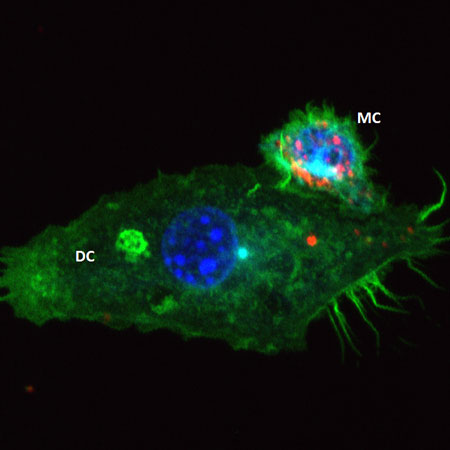Many different cell types are involved in mounting an immune response, but how different cells interact and how interactions might change the immune response is still not fully understood. Mast cells (MCs) and dendritic cells (DCs) are well-known for their roles in immune surveillance. MCs detect allergens and are responsible for the release of histamine and other mediators of the allergic response. DCs patrol the tissues for foreign antigens that they capture and process for presentation to T cells that stimulate an immune response. MCs and DCs are known to exist in the same tissues in the body, in particular environmental interfaces such as skin, lung and intestine. Despite their close proximity, a direct interaction between these cells had not been shown. In a recent study (Carroll-Portillo et al., Journal of Cell Biology 2015), we show that MCs and DCs do interact and this interaction changes the immune response. We used biochemical, immunological, biophysical and live-cell imaging techniques to define the dynamics and physiological consequences of direct communication between MCs and DCs.

We found that MCs and DCs do form stable cell-cell contacts, but this interaction is dependent on MC activation. We observed only short cell-cell contacts on the order of 10 seconds when MCs were inactivated. However, activation of the MCs led MCs to maintain contact with DCs for minutes. Using single cell force spectroscopy, we also showed that the force required to separate activated MCs from DCs was much higher than for resting MCs, indicating the involvement of adhesion molecules in this process. We could block MC-DC interaction by antibodies or small molecule inhibitors that reduced the cell-cell adhesion.
Direct MC-DC interactions were found to alter the immune response at two levels. Firstly, we found that the cytokine production in response to direct contact between immature DCs and activated MCs was altered. Secondly, and quite unexpectedly, we observed that material endocytosed by MCs after antigen activation was subsequently transferred to the DCs. After transfer, the MC antigen was found in early endosomes of the DC, suggesting that the DC might be capable of processing and presenting the newly acquired antigen. To test this possibility, we designed an in vitro experiment to monitor T cell activation. We found that the antigen endocytosed by MCs and transferred to DCs was indeed presented to T cells, and led to T cell proliferation. This new finding revealed a novel mode of antigen sampling that modulates the immune response and suggests a mechanism of propagating MC-centric pathological conditions such as allergy and asthma.


































